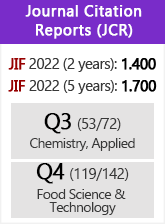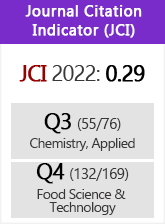Improvement of the lactic acid fermentation of capers through an experimental factorial design (Capparis spinosa L)
DOI:
https://doi.org/10.3989/gya.010510Keywords:
Brine, Capers, Capparis spinosa, Citric acid, Lactic acid, Lactic fermentAbstract
The study of the caper fermentation process through an experiment factorial plan allows us to determine a function ƒ such that (Y= ƒ(X1, X2, …, Xn)) existing between magnitude Y which is the decrease of pH (called response), and variables Xi , which are brine, lactic acid, citric acid and lactic ferment (called factors). A complete factorial plan 24 was made in order to determine the factors and the interactions among the factors which have a statistically significant influence on the studied response. Brine, lactic acid and citric acid have a significant effect on the fall of pH; by contrast, lactic ferment does not have a significant effect. On the other hand, the interactions between brine and lactic acid, between brine and lactic ferment , between lactic acid with citric acid and between lactic acid with lactic ferment have significant effects on the fall of pH (p < 0.0001). The fermentation was done in the research laboratory of the society Marocapres- Fez, international leader in the processing of capers, at a temperature of about 30°C, between June and July.
Downloads
References
Akgül a. 1996. A rediscovered flavor: Capers (Capparis spp.). Gıda 21, 119–128 (in Turkish).
Akinrele IM. 1970. Fermentation studies on maize during the preparation of a traditional African starch-cake food. J. Sci. Food Agric. 21, 619–625. doi:10.1002/jsfa.2740211205
Alvarruiza, Rodrigo M, Miquel J, Giner V, Feria A, Vila R. 1990. Influence of Brining and Packing Conditions on Product Quality of Capers. J. Food Science. 55, 196-198. doi:10.1111/j.1365-2621.1990.tb06051.x
Arslan D, Unver A, Özcan M. 2007. Determination of optimum fermentation quality of capers (Capparis ovata desf. var. canescens) in different brine conditions. J. Food processing and preservation 32, 219-230. doi:10.1111/j.1745-4549.2007.00175.x
Aukrust TW, Blom A, Sandtory BF, Slinde E. 1994. Interactions between starter culture and raw material in lactic acid fermentation of sliced carrot. Lebensm.- Wiss. Technol. 27, 337–341. doi:10.1006/fstl.1994.1069
Fernández Gonzalez MJ, García García P, Garrido Fernández A, Durán Quintana MC. 1993. Microflora of the aerobic preservation of directly brined green olives from Hojiblanca cultivar. J. Applied Microbiology 75, 226-233. doi:10.1111/j.1365-2672.1993.tb02770.x
Fleming HP, Feters RF. 1981. Use of microbial cultures: Vegetable products. Food Technol. 35, 84.
Fleming HP, Feeters RF, Etchells L, Bell TA. 1984. Pickled vegetables. In Compendium of Methods for the Microbiological Examination of Foods (M.L. Speck, ed.) American Public Health Association, Washington, DC, pp. 663–681.
Giuffrida D, Salvo F, Ziino F, Toscano G, Dugo G. 2002. Initial investigation on some chemical constituents of capers (Capparis spinosa L). J. Food Science. 14, 25-33.
Goupy J. 2005. Pratiquer les plans d’expériences. DUNOD/ L’usine nouvelle, French.
Goupy J, Creighton L. 2009. Introduction aux plans d’expériences. DUNOD/L’usine Nouvelle, French.
Joachim V. 2006. Utilization of renewables for lactic acid fermentation. J. Biotechnology 1, 1428-1432. doi:10.1002/biot.200600180 PMid :17136733
Leal-Sánchez MV, Ruiz-Barba JL, Sánchez AH, Rejano L, Jimenez- Diaz R, Garrido A. 2003. Fermentation profile and optimization of green olive fermentation using L. plantarum LPC010 as a starter culture. Food Microbiol. 20, 421–430. doi:10.1016/S0740-0020(02)00147-8
Leroy F, Vuyst LD. 2004. Lactic acid bacteria as functional starter cultures for the food fermentation industry. Trends Food Sci. Technol. 15, 67–78. doi:10.1016/j.tifs.2003.09.004
McDonald LC, Shieh DH, Fleming HP, Feeters RF, Thompson RL. 1993. Evaluation of malolactic-deficient strains of Lactobacillus plantarum for use in cucumber fermentations. Food Microbiol. 10, 489–499. doi:10.1006/fmic.1993.1054
Tolone M, Rajaniemi S, Pihlava JM, Johansson T, Saris PEJ, Ryhänen EL. 2004. Fermentation of nisin, plant derived biomolecules and antimicrobial activity in starter culture fermentations of sauerkraut. Food Microbiol. 21, 167–179. doi:10.1016/S0740-0020(03)00058-3
Marsilio V, Seghetti L, Iannucci E, Russi F, Lanza B, Felicioni M.2005. Use of a lactic acid bacteria starter culture during green olive (Olea europaea L cv Ascolana tenera) processing. J. Science of Food and Agriculture. 85, 1084-1090. doi:10.1002/jsfa.2066
Montaño A, Sánchez AH, Castro A. 2000. Changes in the Amino Acid Composition of Green Olive Brine due to Fermentation by Pure Culture of Bacteria. J. Food Science 65, 1022-1027. doi:10.1111/j.1365-2621.2000.tb09410.x
Mugula JK, Narvhus JA, Sorhaug T. 2003. Use of starter cultures of lactic acid bacteria and yeasts in the preparation of togwa, a Tanzanian fermented food. Int. J. Food Microbiol. 83, 307–318. doi:10.1016/S0168-1605(02)00386-0
Oberman H, Libudzisz Z. 1998. Fermented milks. In Microbiology of Fermented Foods, Vol. 1 (B.J.B. Wood, ed.). Blackie Academic & Professional, London, U.K,pp. 308–350
Oyewole OB, Odunfa SA. 1990. Characterization and distribution of lactic acid bacteria in cassava fermentation during fufu production. J. Appl. Bacteriol. 68, 145–152.
Özcan M. 1999. Use of yoghurt, lactic acide and starter in fermentation in capers (Capparis spp.) flower buds. Food Sci. Technol. 5-13.
Özcan M. 2001. Pickling caper flower buds. J. Food Quality 24, 261-269. doi:10.1111/j.1745-4557.2001.tb00607.x
Özcan M, Akgul a. 1998. Influence of species, harvest date and size on composition of capers (Capparis spp) flower buds. Nahrung-Food 42,102-105. doi:10.1002/(SICI)1521-3803(199804)42:02<102::AID-FOOD102>3.0.CO;2-V
Özcan M, Akgula. 1999. Some compositional characteristics of capers (Capparis spinosa) seed and oil. Grasas y Aceites 50, 49-52. doi:10.3989/gya.1999.v50.i1.635
Pérez Pulido R, Ben Omar N, Abriouel H, Lucas López R, Martínez Cañamero M, Guyot JP, Gálvez A. 2007. Characterization of lactobacilli isolated from caper berry fermentations. J. Applied Microbiology 102, 583-590.
Gardner NJ, Savard T, Obermeier P, Caldwell G, Champagne CP. 2001. Selection and characterization of mixed starter cultures for lactic acid fermentation of carrots, cabbage, beet and onion vegetable mixtures. Int. J. Food Microbiol. 64, 261–275. doi:10.1016/S0168-1605(00)00461-X
Giraud E, Champailler A,Rimbault M. 1994. Degradation of raw starch by a wild amylolitic strain of L. plantarum. Appl. Environ. Microbiol. 60, 4319–4323. PMid :16349456 PMCid:201987
Rodrigo M, Lazaro M, Alvarruiz A, Giner V. 1992. Composition of capers (Capparis spinosa): influence of cultivar, size, and harvest date. J. Food Sci. 57, 1152–1154. doi:10.1111/j.1365-2621.1992.tb11286.x
Romeo V, Ziino M. 2007. Flavour profile of capers (Capparis spinosa L) from the Eolian Archipelago by HS-SPME/GC-MS. Food Chemistry 101, 1272-1278. doi:10.1016/j.foodchem.2005.12.029
Yoon KY,Woodams EE, Hang YD. 2005. Fermentation of beet juice by beneficial lactic acid bacteria. Lebensm.- Wiss. Technol. 38, 73–75. doi:10.1016/j.lwt.2004.04.008
Downloads
Published
How to Cite
Issue
Section
License
Copyright (c) 2010 Consejo Superior de Investigaciones Científicas (CSIC)

This work is licensed under a Creative Commons Attribution 4.0 International License.
© CSIC. Manuscripts published in both the printed and online versions of this Journal are the property of Consejo Superior de Investigaciones Científicas, and quoting this source is a requirement for any partial or full reproduction.All contents of this electronic edition, except where otherwise noted, are distributed under a “Creative Commons Attribution 4.0 International” (CC BY 4.0) License. You may read here the basic information and the legal text of the license. The indication of the CC BY 4.0 License must be expressly stated in this way when necessary.
Self-archiving in repositories, personal webpages or similar, of any version other than the published by the Editor, is not allowed.
















